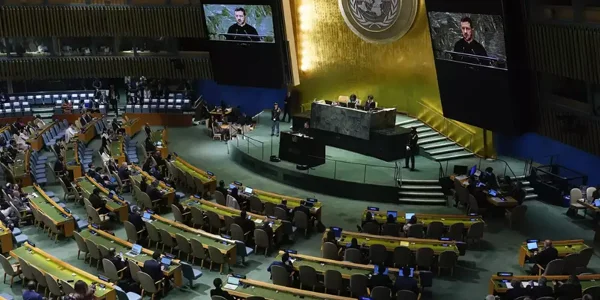On February 24, 2025, marking the third anniversary of the Russia-Ukraine conflict, the United Nations General Assembly (UNGA) witnessed significant diplomatic maneuvers. Two resolutions concerning the war were tabled: one spearheaded by the United States and another by European nations in collaboration with Ukraine. Notably, India chose to abstain from voting on both resolutions, reflecting its nuanced stance on the ongoing conflict.
The Dual Resolutions: US vs. European Approaches

The US-proposed resolution aimed for a swift conclusion to hostilities without explicitly condemning Russia. In contrast, the European-backed resolution called for a “just and lasting peace,” demanding the immediate withdrawal of Russian forces from Ukrainian territory. This divergence highlights the differing strategies: the US focusing on cessation of conflict, while Europe emphasizes accountability and restoration of sovereignty.
India’s Position: A Delicate Balance
India’s abstention from both votes underscores its strategic tightrope walk. Historically, India has maintained a policy of non-alignment, often refraining from taking sides in global conflicts. By abstaining, India signals its desire for peaceful resolution through dialogue without overtly criticizing any party involved. This stance allows India to preserve its diplomatic relations with both Western nations and Russia.
US Abstains from Its Own Resolution
In an unexpected turn, the US abstained from voting on its own resolution. This decision came after European nations successfully introduced amendments that altered the original text, infusing it with language condemning Russian aggression. The US delegation, disagreeing with these changes, chose to abstain, leading to a rare instance where a nation did not support its own proposal. This move highlights the complexities and fractures within Western alliances regarding the approach to the Ukraine crisis.
Voting Outcomes and Global Implications
Both resolutions were adopted with 93 votes in favor. However, the number of abstentions and votes against indicated a fragmented international community. The European-backed resolution saw 18 nations opposing and 65 abstaining, while the US-led proposal faced similar divisions. This split reflects varying geopolitical interests and the challenges in forming a unified global response to the conflict.
Potential Security Council Dynamics
Following the General Assembly votes, attention shifts to the UN Security Council, where the US plans to introduce its resolution. The dynamics here differ significantly due to the veto power held by permanent members, including Russia. The US hopes that allies like France and the UK will support its initiative, but their historical reluctance to use veto power adds uncertainty. The outcome in the Security Council will be pivotal in determining the international community’s next steps regarding the Ukraine conflict.
Conclusion
India’s decision to abstain from both UNGA resolutions highlights its commitment to a balanced and neutral foreign policy amidst complex global tensions. The contrasting approaches of the US and European nations underscore the challenges in achieving a cohesive international strategy to address the Russia-Ukraine war. As the situation progresses, diplomatic engagements and negotiations will be crucial in striving for a peaceful and lasting resolution to the conflict.

